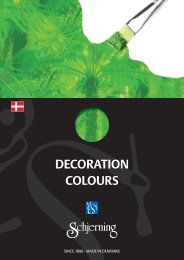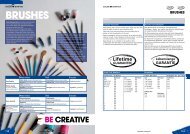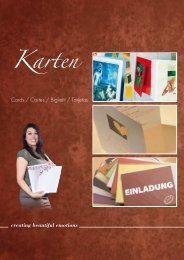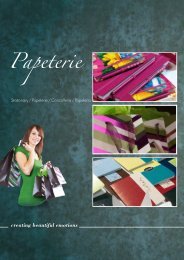Catalogue 2010 / 2011
Catalogue 2010 / 2011
Catalogue 2010 / 2011
Create successful ePaper yourself
Turn your PDF publications into a flip-book with our unique Google optimized e-Paper software.
Glazing rolls<br />
Several heatable steel rolls, which are part of the Fourdrinier<br />
paper machine, and are located at the end of the dry end. The<br />
paper web runs through these rolls and acquires various stages<br />
of smoothness depending on the paper quality and the required<br />
smoothness. Hahnemühle can produce surfaces with various<br />
stages of smoothness on the Fourdrinier paper machine. Hahnemühle<br />
papers and boards, which do not have this smoothness are<br />
called machine finished (paper) or machine glazed (board).<br />
Hand-made paper, mould-made paper<br />
The original way to make paper, which was invented in China<br />
around 2000 years ago. The fibres were scooped out of the fibre<br />
pulp using a frame covered with a wire (screen), the frame was<br />
then shaken until the fibres were evenly distributed over the wire,<br />
removed from the wire (couched) and then dried. Hand-made<br />
papers do not have any grain and represent the most uniform form<br />
of intermatting.<br />
Ingres<br />
High quality, fine drawing paper named after the French artist, Jean<br />
Auguste Dominique Ingres, (1780 to 1867), which Hahnemühle<br />
produces on its cylinder-mould paper machine as mould-made<br />
Ingres paper. It is available laid (vergé), fully stock-sized, with<br />
four-sided real deckle edges and the “rooster“) watermark in 20<br />
colours.<br />
InkJet paper<br />
An important factor for high print quality is the use of special<br />
coated papers, InkJet papers. These papers are “upgraded” or<br />
“converted” with additional surface layers. These layers act as<br />
absorption and reception layers for the ink drops. The coloured<br />
pigments are fixed on the surface and bound, i.e. they do not<br />
penetrate into the lower layers. As a result, high-resolution, true<br />
colour print results with high ink brilliance and faster drying can<br />
be achieved. The high absorption capacity of these layers prevents<br />
the inks or colours from blurring and running into each other<br />
and thus ensures printouts with high edge definition. A further<br />
characteristic is the protection of the printouts from moisture. In<br />
uncoated papers the absorbency properties of the fibre cellulose<br />
(pulp) cause bleeding edges, the inks blot and the colours fade.<br />
ISO 9706<br />
Paper,which has a high degree of permanency, and simultaneously<br />
displays no or only slight changes in the properties, which have an<br />
influence on legibility and handleability if it is stored for a long<br />
period in a protected environment. Hahnemühle papers fulfil the<br />
requirements of DIN ISO 9706:1995 for age resistant paper for<br />
records and print products.<br />
Linters<br />
Short fibres in cotton seeds. These represent a valuable replacement<br />
for rags and satisfy particularly high standards for art papers and<br />
document papers.<br />
XVIII<br />
Mould-made<br />
The term “mould-made“ may only be used for 1. handmade<br />
papers and 2. papers produced on the cylinder mould paper<br />
machine (also called mould paper). Because only with these<br />
production methods is the deckle edge organically formed with<br />
the paper sheet, and only these papers and boards are highly<br />
qualified fine papers. As a traditional mould-made paper factory,<br />
Hahnemühle guarantees its customers that they are buying<br />
“mould-made“.<br />
Neutral sizing<br />
All non-ageing Hahnemühle papers and boards are neutral sized<br />
and thus acid-free. The sizing effect is achieved in the pH-range<br />
above 8.0 by adding synthetic sizes to the mass (pulp). Adding<br />
calcium carbonate (chalk) achieves a lasting alkali setting,which<br />
is prerequisite for a long durability (life).<br />
pH value<br />
The pH value scale ranges from 1-14, whereby the neutral pint is<br />
7. All values below 7 mean acidic and above 7 alkali reaction.<br />
All neutrally sized and non-aging Hahnemühle papers and boards<br />
have a pH value of approx. 8.0 ( Frankfurter Requirements, Certificate).<br />
Depending on the test method used, (cold extraction or<br />
hot extraction), different pH values can be measured in the same<br />
papers.<br />
Profiles<br />
A profile is an equipment description. It contains information<br />
about how a certain device (scanner, monitor or printer) mixes<br />
and reproduces colours.<br />
Sizing<br />
Cellulose fibre naturally absorbs water eagerly and thus changes<br />
its dimensions (becomes larger). In order to slow down this<br />
process, it is coated with additives, such as size (glue), starch,<br />
etc. and made water repellent. A basic differentiation is made<br />
between stock sizing and surface sizing.<br />
Surface<br />
Hahnemühle is able to produce all kinds of different surfaces on<br />
its machines. These are achieved on the one hand using the glazing<br />
rolls, and on the other by the felts used.<br />
Watermark<br />
A permanent mark in paper which appears in the paper, either<br />
due to so-called depletion or enriching of pulps. In sheet formation<br />
the watermark is produced on the wire of the cylinder mould<br />
paper machine by protruding parts (= light-coloured watermark)<br />
or by recessed parts (= dark or shadow watermark), which causes<br />
deliberate differences in the thickness of the paper. In the Fourdrinier<br />
paper machine it is also possible to produce the watermark<br />
using a dandy roll. Here the wire effect described above is achieved<br />
at the start of the suction end on the wire in the still very wet<br />
paper by the fibres being pressed away by the dandy roll.








